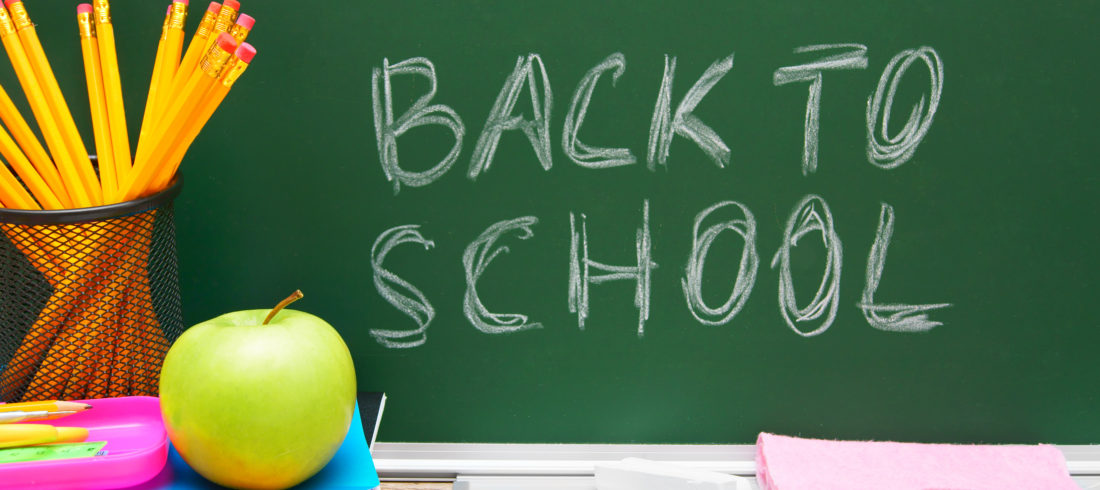As summer comes to a close, there is always a lot to be done to get kids ready to go back to school. Parents, help your kids have a great school year by making sure they are healthy and ready to learn – because healthy students are better learners!
Making the First Day Easier
Many children become nervous about new situations, including changing to a new school, classroom or teacher. This may occur at any age. If your child seems nervous, it can be helpful to rehearse entry into the new situation. Take them to visit the new school or classroom before the first day of school. Remind them that there are probably many students who are uneasy about the first day of school. Teachers know that students are nervous and will make an extra effort to make sure everyone feels as comfortable as possible. If your child seems nervous, ask them what they are worried about and help them problem solve ways to master the new situation.
Backpack Safety
- Choose a backpack with wide, padded shoulder straps and a padded back.
- Pack light. Organize the backpack to use all of its compartments. Pack heavier items closest to the center of the back. The backpack should never weigh more than 10% to 20% of your child’s body weight. Go through the pack with your child weekly, and remove unneeded items to keep it light.
- Remind your child to always use both shoulder straps. Slinging a backpack over one shoulder can strain muscles.
- Adjust the pack so that the bottom sits at your child’s waist.
- If your school allows, consider a rolling backpack. This type of backpack may be a good choice for students who must tote a heavy load. Remember that rolling backpacks still must be carried up stairs, they may be difficult to roll in snow, and they may not fit in some lockers.
Eating During the School Day
- Studies show that children who eat a nutritious breakfast function better. They do better in school, and have better concentration and more energy. Some schools provide breakfast for children; if yours does not, make sure they eat a breakfast that contains some protein
- Most schools regularly send schedules of cafeteria menus home and/or have them posted on the school’s website. With this advance information, you can plan to pack lunch on the days when the main course is one your child prefers not to eat.
- Look into what is offered inside and outside of the cafeteria, including vending machines, a la carte, school stores, snack carts and fundraisers held during the school day. All foods sold during the school day must meet nutrition standards established by the US Department of Agriculture (USDA). They should stock healthy choices such as fresh fruit, low-fat dairy products, water and 100% fruit juice. Learn about your child’s school wellness policy and get involved in school groups to put it into effect. Also, consider nutrition if you child will be bringing food to eat during school.
Develop a Sleep Routine
- Getting enough sleep is critical for a child to be successful in school. Children who do not get enough sleep have difficulty concentrating and learning as well as they can.
- Set a consistent bedtime for your child and stick with it every night. Having a bedtime routine that is consistent will help your child settle down and fall asleep. Components of a calming pre-bedtime routine may involve a bath/shower, reading with them, and tucking them in and saying goodnight to them.
- Have your child turn off electronic devices well before bedtime.
- Try to have the home as quiet and calm as possible when younger children are trying to fall asleep.
- Insufficient sleep is associated with lower academic achievement in middle school, high school and college, as well as higher rates of absenteeism and tardiness. The optimal amount of sleep for most younger children is 10-12 hours per night and for adolescents (13-18 year of age) is in the range of 8-10 hours per night. See Healthy Sleep Habits: How Many Hours Does Your Child Need? for more information.
Developing Good Homework & Study Habits
- Create an environment that is conducive to doing homework starting at a young age. Children need a consistent workspace in their bedroom or another part of the home that is quiet, without distractions, and promotes study.
- Schedule ample time for homework; build this time into choices about participation in after school activities.
- Establish a household rule that the TV and other electronic distractions stay off during homework time.
- Supervise computer and Internet use.
- Be available to answer questions and offer assistance, but never do a child’s homework for her.
- Take steps to help alleviate eye fatigue, neck fatigue and brain fatigue while studying. It may be helpful to close the books for a few minutes, stretch, and take a break periodically when it will not be too disruptive.
- If your child is struggling with a particular subject, speak with your child’s teacher for recommendations on how you or another person can help your child at home or at school. If you have concerns about the assignments your child is receiving, talk with their teacher.
- If your child is having difficulty focusing on or completing homework, discuss this with your child’s teacher, school counselor, or health care provider.
- For general homework problems that cannot be worked out with the teacher, a tutor may be considered.
- Some children need extra help organizing their homework. Checklists, timers, and parental supervision can help overcome homework problems.
- Some children may need help remembering their assignments. Work with your child and their teacher to develop an appropriate way to keep track of their assignments – such as an assignment notebook.

